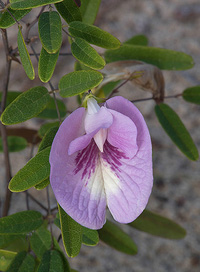Pigeon wings facts for kids
Quick facts for kids Pigeon wings |
|
|---|---|
 |
|
| Conservation status | |
| Scientific classification | |
| Kingdom: | |
| (unranked): | |
| (unranked): | |
| (unranked): | |
| Order: | |
| Family: | |
| Genus: |
Clitoria
|
| Species: |
C. fragrans
|
| Binomial name | |
| Clitoria fragrans Small
|
|
| Synonyms | |
|
Clitoria pinetorum |
|
Clitoria fragrans, also known as pigeon wings or sweet-scented pigeon wings, is a very special and rare flowering plant. It belongs to the legume family, which includes peas and beans. This plant is found only in Central Florida, USA. It is considered a federally threatened species, meaning it needs protection to survive.
Contents
What Does the Pigeon Wings Plant Look Like?
This plant is a perennial herb or a small subshrub. It can grow up to half a meter tall, sometimes even one meter. It has a strong, woody taproot that helps it survive.
The stems are thin, purplish, and feel a bit waxy. Its leaves grow in an alternating pattern along the stem. Each leaf has three long, oval-shaped leaflets. These leaflets are green and can be up to 4.5 centimeters long.
Flowers and Seeds
The plant produces one or two sweet-smelling flowers where the leaves meet the stem. Each flower can be up to 5 centimeters long. They are usually light pinkish-purple. You might see darker rose-pink stripes in the middle and a white spot underneath.
The flowers are unique because they are resupinated. This means the flower twists so its reproductive parts point backward. This design helps insects rub against them to pick up pollen.
There is also a second type of flower that often appears. These flowers are cleistogamous, meaning they self-pollinate and do not open up. These closed flowers are generally more common. However, the showy, open flowers might appear more often after a wildfire.
Both types of flowers produce fruit. The fruit is a legume pod, like a pea pod, up to 5 centimeters long. Inside, there are up to nine reddish seeds, each a few millimeters long. The seeds are sticky, which helps them stick to animals for spreading to new places.
Where Does the Pigeon Wings Plant Live?
This plant grows in natural, untouched areas of Florida scrub habitat. It often lives in the transition zones between scrub and sandhill areas. It prefers open spaces where it gets plenty of sunlight and is not shaded by taller trees or bushes.
The Role of Wildfire
Wildfires happen naturally and often in this type of habitat. These fires are important because they help keep the taller plants from growing too much. This allows smaller herbs and shrubs, like the pigeon wings plant, to get enough light. The plant's deep taproot helps it survive fires. After a fire, it can grow back from its roots.
The pigeon wings plant grows in dry, high areas of the scrub. It can be found in white, yellow, and gray sand types.
Protected Areas
This plant is found in several different locations across Florida. Many of these areas are protected lands. These include:
- Seminole State Forest
- Lake Wales Ridge State Forest
- Lake Wales Ridge National Wildlife Refuge
- Allen David Broussard Catfish Creek State Park
Many plants also grow on the Avon Park Air Force Range. The military must watch over these plants because the species is federally threatened.
Why is the Pigeon Wings Plant Threatened?
The pigeon wings plant faces several dangers that threaten its survival.
Habitat Loss
One major threat is habitat destruction and fragmentation. Much of the Florida scrub, where this plant lives, has been cleared. This land is often used for building homes or for farming, such as growing orange groves. When its habitat is destroyed or broken into smaller pieces, the plant has fewer places to grow and thrive.
Animal and Insect Threats
The plant is also very appealing to certain animals. White-tailed deer and eastern cottontails enjoy eating its leaves. This can harm the plant, especially if too much of it is eaten.
The pigeon wings plant is also a host plant for many butterfly species. This means butterflies lay their eggs on it and their caterpillars eat its leaves. Some of these butterflies include the long-tailed skipper (Urbanus proteus) and the southern cloudywing (Thorybes bathyllus). While butterflies are beautiful, too many caterpillars can damage the plant.
Finally, the seeds of the plant are often eaten, possibly by beetles. If too many seeds are eaten, fewer new plants can grow, which also threatens the species.


